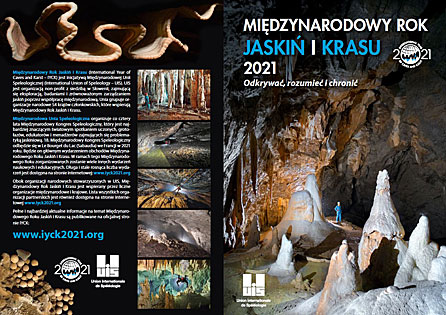 CBDG Caves Subsystem
CBDG Caves Subsystem
The Central Geological Database Caves Subsystem  contains standardized location, morphometric, bibliographic, nature data (geology, hydrology, biology, archeology, climatology and environmental protection), descriptive data (history of research, exploration and documentation) and graphic attachments (plans, sections and photos) according to the state of knowledge for the year, in which they were developed or updated. They are an excellent starting material for scientific specialized research. They reflect the authors' knowledge and maintain their style of description. This knowledge has been collected by the Polish Society of Friends of Earth Sciences (PTPNoZ) since the 1970s until today in the course of inventory work carried out by Polish speleologists. The aim of these activities is to obtain a complete set of documentation from all over Poland and to update them successively. The website is also a source of reference spatial data.
contains standardized location, morphometric, bibliographic, nature data (geology, hydrology, biology, archeology, climatology and environmental protection), descriptive data (history of research, exploration and documentation) and graphic attachments (plans, sections and photos) according to the state of knowledge for the year, in which they were developed or updated. They are an excellent starting material for scientific specialized research. They reflect the authors' knowledge and maintain their style of description. This knowledge has been collected by the Polish Society of Friends of Earth Sciences (PTPNoZ) since the 1970s until today in the course of inventory work carried out by Polish speleologists. The aim of these activities is to obtain a complete set of documentation from all over Poland and to update them successively. The website is also a source of reference spatial data.
Access to the data
The data of the CBDG Caves subsystem is available free of charge on the Internet in several ways
CBDG Caves of Poland Application – search criteria
Caves are natural objects of a very complex nature. The genesis of each of them is the result of the interaction of various geological processes. The characteristics of the rocks in which these processes take place (mineral composition, structure and texture, porosity or strength parameters), the geological history of the area of their occurrence, spatial conditions and changes that occur as a result of all geological processes known to dynamic geology, especially and erosion, corrosion and sedimentation, tectonic movements, climate change and many other natural processes.
During the formation and evolution of the cave, each of these processes played a role - at some stages it was dominant, at others - only minimal, and some of them showed a constant influence of varying intensity. Along with the cave and the surrounding space, its internal environment also changed. These changes can be read from the accumulated sediments, remains of organisms, dripstone formations, karst relief or traces of rock mass tectonics.
The descriptions of the caves are based on the authors' observations made in the course of inventory works and data from the literature on the subject. The degree of their detail and the substantive content of individual studies depend on the authors' knowledge and the state of scientific research carried out for a given cave before its documentation was prepared. Therefore, the content of the CBDG Caves Subsystem should not be treated as a scientific monograph of caves, but as the basic material helpful for its creation and planning appropriate research.
The criteria for searching for caves are divided into formal and substantive. Formal criteria allow you to filter objects by their name (with synonyms), inventory number, region, administrative division and morphometric data, as well as the land owner, form of nature protection, author of the study (or graphic appendix) and according to the update status for a given year. The substantive criteria relate to geological terminology (genesis, stratigraphy, lithology, sedimentology, palaeontology, tectonics), biological and climatology. They also allow you to search for fragments of the cave description or geographic location.
Presented in Caves of Poland Application data from the CBDG Caves Subsystem also contains information about caves known from literature, although not available today (collapsed, flooded, not found). It also allows you to check which of the objects are located in the area at risk of mass surface movements - the caves occurring within the landslides have been marked.
Specialized research is necessary to precisely determine the genesis of the cave. For many caves, however, the authors do not provide sufficient information, hence the website data presents a different degree of detail. For this reason, a conventional and deliberately simplified set of keywords was adopted for searching by genesis. The following terms are related to caves with the following meaning:
- crevice - for all objects, the creation of which was conditioned by the expansion of the cracks existing in the massif as a result of the interaction of various forces (pressures), regardless of the type of these forces;
- karst - for objects created mainly due to simultaneous erosion and corrosion processes of flowing waters;
- weathering - for facilities where the ventilation processes played a major role;
- erosive - for objects formed as a result of erosion of surface water streams;
- fissure-karst and karst-fissure - define the dominant factor in creating the object
- volcanic - for objects created as a result of volcanic processes.
Similarly, in order to simplify the grouping of caves according to common microclimatic features, the following dictionary entries were conventionally assigned to them:
- within the range of surface atmospheric changes - for usually small, fully lit objects;
- static - for objects with an even, stable climate, usually longer than a dozen or so meters (unless the author clearly specified this element of the environment);
- dynamic - for objects where the air movement is not short-term, variable air movement between the entrances to cave (unless the author clearly specified the nature of the microclimate);
- whiff - for objects where there is a clear air exhaust from the depth of the massif or air flow from the cave entrance to the interior
Wherever the description lacks information on a specific issue, the keyword "no data" was used, while in the case of the author finding that a specific element does not appear in the list, the keyword "does not exist" .
Proper operation of the CBDG Caves of Poland Application requires unblocking "pop-ups" in the browser internet options. NOTE - Only in Polish
News – International Year of Caves and Karst
 International Year of Caves and Karst – IYCK is an initiative of the International Union of Speleology – UIS. UIS is a non-profit organization based in Slovenia dedicated to the exploration, research and sustainable management of caves through international cooperation. The Union groups together the national organizations of 54 member countries that support the International Year of Caves and Karst. The full and most up-to-date information on the International Year of Caves and Karst is published on the official IYCK website: www.iyck2021.org.
International Year of Caves and Karst – IYCK is an initiative of the International Union of Speleology – UIS. UIS is a non-profit organization based in Slovenia dedicated to the exploration, research and sustainable management of caves through international cooperation. The Union groups together the national organizations of 54 member countries that support the International Year of Caves and Karst. The full and most up-to-date information on the International Year of Caves and Karst is published on the official IYCK website: www.iyck2021.org.
About the Caves of Poland Project
The first works of collecting and organizing knowledge about Polish caves were undertaken in 1974 on the initiative of Dr. Jerzy Grodzicki by the Polish Society of Friends of Earth Sciences (PTPNoZ). At that time, the Cave Inventory Team, led by the originator, was established. Initially, the team documented only the Tatra caves. In 1993, the project of extending the works to all cave areas was recommended by the State Council for Nature Conservation. In 1994, the Minister introduced the "Instruction for the preparation of cave documentation", standardizing the methods of inventory. At the same time, the Ministry of Environment started financing further works. The aim of these works was to obtain morphometric and location data as well as natural data: geology, hydrology, biology, archeology, climatology and environmental protection, as well as historical data related to research, exploration and documentation. As a result of these activities, a publishing series was created presenting documentations of Polish caves grouped regionally.
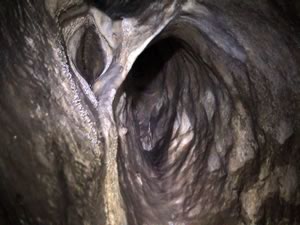 In the years 2008-2011, as a result of the combined forces, knowledge and resources of PTPNoZ and PGI-NRI, the Caves subsystem was created in the Central Geological Database together with an online application for data presentation called "Polish Caves" (according to the concept of Jerzy Grodzicki and Ewa Machalska). Documents from various regions of Poland collected so far by PTPNoZ have gained wide access in this way.
In the years 2008-2011, as a result of the combined forces, knowledge and resources of PTPNoZ and PGI-NRI, the Caves subsystem was created in the Central Geological Database together with an online application for data presentation called "Polish Caves" (according to the concept of Jerzy Grodzicki and Ewa Machalska). Documents from various regions of Poland collected so far by PTPNoZ have gained wide access in this way.
In the next stage of the project (2013-2016), all documentation previously entered into the database was verified. More than 1050 new data for the caves of the Carpathians, the Tatra Mountains and the Olkusz Upland were also compiled and introduced, which was the material for six subsequent volumes of the inventory series. Thus, the number of volumes in the series increased to 32. The resources of the base were also supplemented with updated documentation of about 90 caves in the Sudetes.
The mission of the project is to achieve the most complete possible database of Polish caves and to update it systematically. The content of the database comes from measurements and observations made by speleologists in the course of field and chamber works, so the scope and degree of detail of information for individual caves varies. It depends on the knowledge of the authors and the state of scientific research carried out so far in a given cave (study of literature and archival materials as well as publications in speleological and scientific journals).
The cave documentation includes detailed data with graphic attachments and the location on an interactive map. Geographic coordinates - where possible - were determined with an accuracy of one second. The exceptions are the few objects covering the habitats of protected species, where the location is given to a large extent, and the description of the route to the borehole has been hidden.
In addition to the organized form of inventory work, so far financed regularly by the National Fund for Environmental Protection and Water Management, we enable you to participate in individual updating of data. The preferred form of voluntary and free of charge submission of comments, additions to cave descriptions or photos of holes is the use of the contact form (cave details - the "Add comments" button). The data in the database is not supplemented on the basis of oral reports on new discoveries or undocumented press reports.
Caves regionalization
Caves in Poland occur in various regions, mainly in its southern part, in the areas of mountains and highlands. Few of them can also be found in the widely understood Polish Lowlands, from the Baltic coast to the foreland of the uplands in southern Poland. Except for the area of the Polish Lowlands, where caves are a rare and sporadic phenomenon, caves generally occur in easily geomorphologically defined areas, where their geological structure allows them to form.
To facilitate the identification of individual caves, the area of Poland has been divided into regions of their occurrence. They are marked in the database with letters, while within the separated regions (depending on the area and number of caves there) smaller units marked with letters or numbers (e.g. K.Bd , G- 4 ) This breakdown is as follows:
- The Tatra Mountains - T
- Caves of the Western Tatra Mountains
- Caves of the High Tatra Mountains
- The Pieniny Mountains - P
- Caves of the western part of the Pieniny Rock Range
- Polish Flysch Carpathians - K
- Caves of the Beskid Śląski Foothills - K.Ps
- Caves of the Beskid Śląski - K.Bs
- Caves of the Żywiec Valley - K.Kż
- Caves of the Beskid Żywiecki - K.Bż
- Caves of the Beskid Mały - K.Bm
- Caves of the Beskid Makowski - K.Bmk
- Caves of the Wiśnicz Foothills - K.Pw
- Caves of the Beskid Wyspowy - K.Bw
- Caves of the Gorce - K.G
- Caves of the Beskid Sądecki - K.Bsd
- Caves of the Rożnów Foothills - K.Pr
- Caves of the Ciężkowickie Foothills - K.Pc
- Caves of the Beskid Niski - K.Bn
- Caves of the Dynowskie Foothills - K.Pd
- Caves of the Sanocko-Turczańskie Mountains - K.Gst
- Caves of the Bieszczady - K.Bd
- Silesian-Kraków Upland - J
- Caves of the Wieluń Upland - J.Wl
- Caves of the Częstochowa Upland - J.Cz
- Caves of the Olkusz Upland - J.Olk
- Caves of the Silesian Upland - J.Śl
- Caves of the Garb Tenczyński - J.GT
- Caves of the Kraków Gate - J.Bk
- The Świętokrzyski Region - G
- Caves of the Kielce subregion - G-1
- Caves of the Chęciny subregion - G-2
- Caves of the Łagowsko-Klimontowski subregion - G-3
- Caves of the Łysogórski subregion - G-4
- Caves of the Małogosko-Morawicki subregion - G-5
- Caves of the Konecko-Opoczyński subregion - G-6
- Caves of the Szydłowiecko-Ostrowiecki subregion - G-7
- Caves of the Iłżecko-Wierzbicki subregion - G-8
- The Nida Trough
- The Polish Lowland
- Caves of the Polish Lowland - NP
- The Sudetes - S
- Caves of the Eastern Sudetes - S.I
- Caves of the Central Sudetes - S.II
- Caves of the Western Sudetes - S.III
- Caves of the Western Sudetes foothills - S.IV
- Caves of the Sudetic Foreland - S.V
Geology
From a geological point of view, caves provide spatial data about the internal structure of their range. They are the surviving traces of the ancient history and subsequent stages of the evolution of the area morphology. Their dripstone form (regardless of natural beauty) records the climatic changes of the area.
 Caves are generally formed as a result of the long-term influence of various geological processes on rocks: tectonic movements, dissolution, erosion, weathering and accumulation. Therefore, if a cave was created as a result of the dissolution of the rock by water (or solutions) circulating in the crevices, we speak of its karst origin. This applies to rocks that are susceptible to dissolution by water, such as limestones, dolomites, gypsum or salt. However, in such cases, an important factor is always the existence of tectonically obtuse fractures that allow water to flow. Thus, most karst caves have a fissure karst genesis which is superimposed by erosion and weathering.
Caves are generally formed as a result of the long-term influence of various geological processes on rocks: tectonic movements, dissolution, erosion, weathering and accumulation. Therefore, if a cave was created as a result of the dissolution of the rock by water (or solutions) circulating in the crevices, we speak of its karst origin. This applies to rocks that are susceptible to dissolution by water, such as limestones, dolomites, gypsum or salt. However, in such cases, an important factor is always the existence of tectonically obtuse fractures that allow water to flow. Thus, most karst caves have a fissure karst genesis which is superimposed by erosion and weathering.
In the case of insoluble rocks, such as granites or sandstones, most of them are tectonic, weathering and erosive genesis of caves.
In the silts of the caves, we find fragments of rocks brought by previously flowing streams. This often allows to reconstruct the old ways of water circulation. The pollen of plants contained in the silt indicates the type of ancient flora and the climate. Often in the silt, bone remains of the ancient fauna from the end of the Cenozoic can be found, and often archaeological artifacts - the remains of ancient Palaeo- and Neolithic cultures.
Flora and fauna
A completely different cave environment is caused by the complete lack of light and a specific microclimate. This environment is conducive to the preservation of unique forms of fauna and flora, often surviving from the Pleistocene and even the Pliocene. At present, about 7,000 species of troglobionts are known, i.e. organisms that constantly live in caves and other underground life zones (mainly invertebrates).
 It is estimated that this amount can be two to three times greater. Many of these species have survived from previous geological periods (mainly the Pleistocene). Recognition of the fauna of Polish caves is, so far, preliminary. Only a few groups of animals have been studied, and only in a small number of caves.
It is estimated that this amount can be two to three times greater. Many of these species have survived from previous geological periods (mainly the Pleistocene). Recognition of the fauna of Polish caves is, so far, preliminary. Only a few groups of animals have been studied, and only in a small number of caves.
Knowing the flora is even worse. So far, studies have been sparse and covered an even smaller number of objects. Research on bryophytes was conducted in some caves. Our knowledge of the fungi, lichens, algae and bacteria found in the caves is negligible. The information in the documentation on this subject mainly concerns the presence of flora at the entrance, on the ground surface, within the range of the cave's microclimate and inside the cave within the range of incoming light.
Protection
In most nature conservation studies, projects and programs, caves are usually overlooked as objects that require constant, strict protection. There are two reasons for this. The first is the lack of sufficient knowledge about caves and their natural resources. This applies to both institutions and people supervising nature protection, as well as services established to implement this protection. The second reason is the problem of classifying these unique natural objects to the commonly accepted categories of protected objects.
 They are classified either as areas where certain species of animals or plants occur, or as areas where certain forms of inanimate nature or groups of them occur. The caves do not meet these criteria. In terms of the criteria adopted, they do not constitute "areas". At the same time, they are objects of inanimate nature, they constitute a unique environment of fauna and flora communities that do not occur outside caves.
They are classified either as areas where certain species of animals or plants occur, or as areas where certain forms of inanimate nature or groups of them occur. The caves do not meet these criteria. In terms of the criteria adopted, they do not constitute "areas". At the same time, they are objects of inanimate nature, they constitute a unique environment of fauna and flora communities that do not occur outside caves.
Caves are accessible to humans fragments of the underground water circulation network. As a result, they are the most susceptible to anthropogenic pollution in the feeding areas of karst aquifers.
The beauty of the caves causes a growing tourist interest. Sports opportunities offered by the largest and deepest cave systems attract cave mountaineers. Therefore, there is an urgent need to protect the valuable assets of caves from damage. It is necessary to create appropriate forms of this protection, on the one hand, and on the other hand, to create ways to make caves available for tourist and sports purposes. This is especially important for non-protected areas, i.e. outside national and landscape parks.
The biological importance of cave ecosystems, as well as their sensitivity to pollution and microclimate disturbances, require greater emphasis on systematic research and protection of caves.
Knowledge about caves should be included in spatial development plans. It is important for many types of investments, in particular: road construction, water construction, water supply and waste management. In the recent past, there are known cases where this subject was not taken into account in planning works, which resulted in additional, enormous costs (e.g. Przeczyce reservoir, Sulejów reservoir).
Links
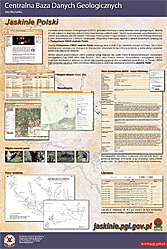 There is a huge amount of information about caves on the Internet. We recommend only a few selected websites containing general information, not related to individual regions of Poland and the world:
There is a huge amount of information about caves on the Internet. We recommend only a few selected websites containing general information, not related to individual regions of Poland and the world:
- Museum of the Polish Geological Institute
- Cave Climbing Commission of the Polish Mountaineering Association
- Speleological Section of the PTP name Copernicus
- Wikipedia
- Spatial data
Contact
Management of the CBDG Subsystem Caves and the application
Polish Geological Institute – NRI
Central Geological Database (CBDG)
ul. Rakowiecka 4, 00-975 Warszawa
e-mail: kolekcje@pgi.gov.pl
Substantive content of the data
Polish Society of Friends of Earth Sciences
Main Board
Nowolipki 24 basement. 7-8, 01-019 Warszawa
e-mail: ptpnoz.zg@pro.onet.pl
tel/fax: (+48) 22 621 69 51

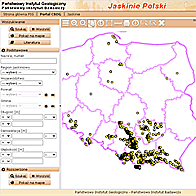 CBDG Caves of Poland
CBDG Caves of Poland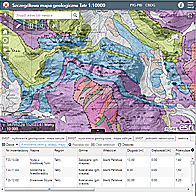 CBDG GEOLOGIA Portal
CBDG GEOLOGIA Portal GeoLOG Application
GeoLOG Application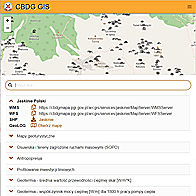 CBDG GIS map services
CBDG GIS map services CBDG Download Manager
CBDG Download Manager